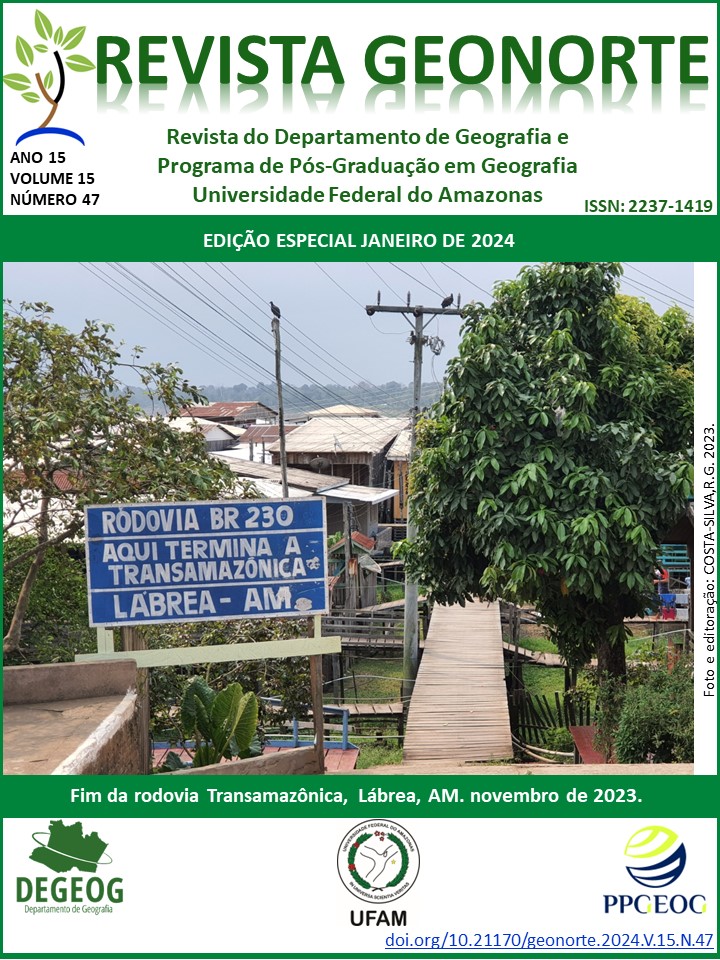The Amazon in the context of school geography, a necessary discussion from student perception
The Amazon in the context of school geography, a necessary discussion from student perception
DOI:
https://doi.org/10.21170/geonorte.2024.V.15.N.47.177.194Keywords:
Amazônida; Percepção Discente; Ensino de Geografia; Norte mato-grossense.Abstract
Along the decades, the Amazon faces various forms of looting, violations and spoliation, phenomena that have intensified with the advance of capital. Through capitalist logic, it is seen only as a resource and inexhaustible source of wealth. Its particularities and sociodiversity are disregarded and, often, denied. This research is characterized as exploratory, with a qualitative-quantitative approach, the procedures used consisted of bibliographical and documentary survey and analysis and also field research. The objective of this study is to analyze how students in the 8th year of public Elementary School, located in the north of the state of Mato Grosso, perceive the Amazon in the context of School Geography. Part of the results revealed that the majority of participants identify the Amazon as a “forest”, inhabited only by “Indians and animals”, whose maintenance is very important for the production of oxygen. Regarding location, many students responded that the Amazon is in the state of Amazonas, therefore, they do not identify themselves as amazonian. The situation is worrying, as these students are unaware of the proposed theme and there is a voluntary or involuntary denial of the Amazon in their lives, a fact that can contribute to society's neglect, disregard and lack of interest in the socio-environmental reality of the largest tropical forest in the world.
Downloads
References
ALBAGLI, S. Amazônia: fronteira geopolítica da biodiversidade. Parcerias estratégicas, v. 6, n. 12, p. 05-19, 2010. Disponível em: <https://ridi.ibict.br/ bitstream/123456789/105/1/AlbagliParcerias2001.pdf>. Acesso em: 01 set. 2023.
BARBOSA, S. F.; ROCHA, G. O. R.da; LIRA, J. R. O. A noção de Amazônia e a categoria de região no ensino de geografia: das representações sociais dos alunos à construção de sua identidade. Revista Brasileira de Educação em Geografia, v. 11, n. 21, p. 05-27, 2021. Disponível em: <https://www.revistaedugeo.com.br/revistaedugeo/article/ view/994>. Acesso em: 15 ago. 2023.
BECKER, B. K. Amazônia. 5. ed. São Paulo: Ática, 1990.
COSTA JUNIOR, W. R.; THOMÉ, Z. R. C. Representações geográficas da Amazônia brasileira no livro didático de geografia do 4º ano do ensino fundamental: limites e desafios ao trabalho pedagógico do professor. Humanidades & Inovação, v. 9, n. 23, p. 243-257, 2022. Disponível em<https://revista.unitins.br/index.php/humanidadeseinovacao/article/view/6121>. Acesso em: 10 set. 2023.
COSTA SILVA, R. G. da. A desamazonização da Amazônia: conflitos agrários, violência e agrobandidagem. Conflitos no Campo Brasil 2021. v. 1, p. 104-111, 2022. Disponível em: <https://www.cptnacional.org.br/>. Acesso em: 10 set. 2023.
FLORES, C. S.; OLIVEIRA, A. L. S. Por que a Amazônia não é o pulmão do mundo? X Congresso de Educação do Norte Pioneiro, Jacarezinho. 2010. Anais... UENP. Universidade Estadual do Norte do Paraná. Centro de Ciências Humanas e da Educação e Centro de Letras Comunicação e Artes. Jacarezinho, 2010. ISSN: 18083579. p. 602 a 610.
PORTO-GONÇALVES, C. W. Amazônia, amazônias. Editora Contexto, 2005.
LEFF, E. Complexidade, racionalidade ambiental e diálogo de saberes. Educação & Realidade, Porto Alegre, [S. l.], v. 34, n. 3, 2009. Disponível em: <https://seer.ufrgs. br/index.php/educacaoerealidade/article/view/9515>. Acesso em: 18 set. 2023.
NOBRE, A. D. O futuro climático da Amazônia. São Paulo: Green, 2014.
OLIVEIRA, A. U. A fronteira amazônica mato-grossense: grilagem, corrupção e violência. São Paulo: Landé Editorial, 2016.
PICOLI, F. Amazônia: o silêncio das árvores, uma abordagem sobre a indústria de transformação de madeiras. Sinop: Editora Fiorelo, 2004.
ROCHA, G. O. R. da; AMORAS, I. C. R. O ensino de geografia e a construção de representações sociais sobre a Amazônia. Terra Livre, v.1, n. 26, 2006. Disponível em: . Acesso em: 20 ago. 2023.
SANTOS, D.; SALOMÃO, R.; VERÍSSIMO, A. Fatos da Amazônia 2021, Amazônia 2030. Centro de Empreendedorismo da Amazônia, Imazon. Disponível em: <https://amazonia2030.org.br/wp-content/uploads/2021/04/AMZ2030-Fatos-da-Amazonia-2021-3.pdf> Acesso em 05 de set. 2023.
SILVA, C. A. F. A fronteira agrícola capitalista da soja na Amazônia. Revista da Sociedade Brasileira de Geografia, v. 1, n. 1, 2006. Disponível em: <https://doi.org/10.1590/S1414-753X2012000200002> Acesso em 05 de set. 2023.
SILVA, C. A. F. Fronteira agrícola capitalista e ordenamento territorial. In: SANTOS, Milton et al. Território, territórios: ensaios sobre o ordenamento territorial. Ed. Lamparina, 3.ed. Rio de Janeiro, 2007.
SILVA, R. M. Transformações socioeconômicas e ambientais do município de Vera/MT: discussões histórico-geográficas e o ensino de geografia no contexto. 2019. 213f. Dissertação (Mestrado em Geografia) – Programa de Pós-Graduação em Geografia. Universidade Estadual do Mato Grosso, UNEMAT, Campus Cáceres. Cáceres, MT, 2019.
SOUZA, L. P.; MENDONÇA, P. de L. V. Experiência educativa e estereótipo regional amazônico. Disponível em: <http://www.cbg2014.agb.org. br/resources/anais/1/1404324778_pdf>. Acesso em 05 de set. 2023.
TEIXEIRA, L. A colonização no norte de Mato Grosso: o exemplo da gleba celeste. 2006. 117 f. Dissertação (Mestrado) – Programa de Pós-Graduação em Ciências e Tecnologia. Universidade Estadual Paulista, Faculdade de Ciências e Tecnologia, São Paulo, SP, 2006.
Downloads
Published
How to Cite
Issue
Section
License
Autores que publicam nesta revista concordam com os seguintes termos:
- Autores mantém os direitos autorais e concedem à revista o direito de primeira publicação, com o trabalho simultaneamente licenciado sob a Licença Creative Commons Attribution que permite o compartilhamento do trabalho com reconhecimento da autoria e publicação inicial nesta revista.
- Autores têm autorização para assumir contratos adicionais separadamente, para distribuição não-exclusiva da versão do trabalho publicada nesta revista (ex.: publicar em repositório institucional ou como capítulo de livro), com reconhecimento de autoria e publicação inicial nesta revista.
- Autores têm permissão e são estimulados a publicar e distribuir seu trabalho online (ex.: em repositórios institucionais ou na sua página pessoal) a qualquer ponto antes ou durante o processo editorial, já que isso pode gerar alterações produtivas, bem como aumentar o impacto e a citação do trabalho publicado (Veja O Efeito do Acesso Livre).






